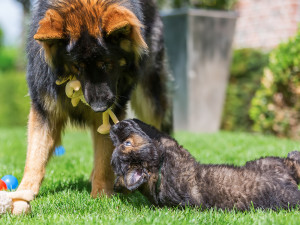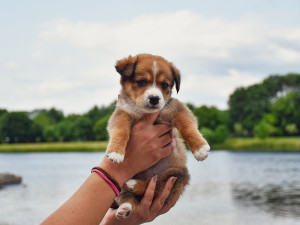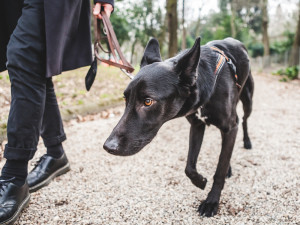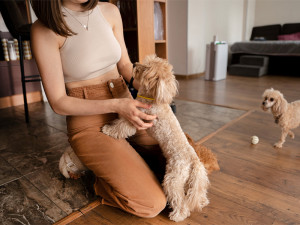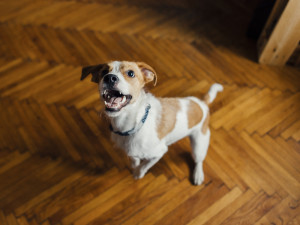Does Your Dog Have Juvenile Onset Shyness?
Turns out, the teenage years aren’t just tough for humans – they can be rough on dogs, too

Share Article
I was walking Rosie, a happy, well-socialised, nine-month-old chocolate Lab near my house when she uncharacteristically barked and stiffened. I could tell that something had spooked her even before I looked up to see a man with a big, floppy hat working on his mountain bike in his front garden. Luckily, the man was not only unfazed by Rosie’s reaction, but he was also pretty dog savvy. He immediately removed his hat, knelt down, and said to Rosie, “Hey, there, I’m not really that scary am I?” in a calm, cheerful voice. She responded by wagging her tail enthusiastically in her usual, friendly way.
It was the second time in two days that Rosie had been startled by someone who previously would not have bothered her, so I knew she was entering a new developmental fear period that is common as puppies approach a year of age. Many young dogs become more fearful of new people and new things than they were as puppies. My mentor, Dr Patricia B McConnell, PhD half-jokingly called it ‘juvenile onset shyness’ because so many sociable dogs become a little nervous as they leave puppyhood and enter adolescence.
If your adolescent dog suddenly seems a little skittish but has previously been confident, it is likely that your dog is just entering a normal developmental fear period during which new things (and even not so new things) scare them. It’s so useful for people to know that this stage is temporary and that it is completely normal.
Within a few months, your dog is likely to be just as social and happy about whatever the world brings their way as they were when they were a puppy. If your puppy always found the world to be a scary place, they will most likely continue to be cautious or fearful as an adult, but they may be even more so in adolescence.
What does a fearful dog look like?
Fear-based behaviour can vary widely – from cowering under the table when a motorbike roars by to lunging at and even biting visitors. People don’t always recognise this as fearful behaviour. Fearful dogs may also adopt telltale body postures: crouching in a lowered body position or lying down and freezing. Many dogs whine, bark or make other distress sounds.
Most dogs move past this ‘fear period’ without any special care from their humans. However, your behaviour can make a big difference in how this fearful period affects your dog, and there are ways to help your dog as they are going through it.
How to help your puppy when they become fearful
When your dog is spooked by something, follow these general guidelines:
Talk in a relaxed, cheerful way to your dog, perhaps saying, “Yes, that’s a really loud motorbike, isn’t it? Oh, look, there it goes down the road.” Obviously, your dog won’t know what you are saying, but your normal conversational tone of voice can help your dog calm down.
If your dog wants to be near you, feel free to pet or play with them. You want them to come to you when they need to feel more secure. There is no need to worry that you are reinforcing your dog’s fears. You are just providing comfort, as you should.
Don’t panic or react dramatically. If your dog is out of control, it is all the more critical that you stay relaxed. Try to control your own startled response to your dog’s barking or lunging, if possible.
Don’t force your dog to approach something that they fear. Doing so will just make them more scared, which is counterproductive. If your dog wants to get away, that’s fine. Sometimes, the best thing you can do is minimise their exposure to something overwhelming, even if that means turning and heading the other way. Don’t make a big deal of stopping suddenly, saying, “Oh, no!” and hightailing it out of there. Just calmly turn and move away from what is scaring your dog so that they don’t get any more worked up. If your dog can count on you to get them out of situations that scare them, that is good for their confidence and builds their trust in you.
Show your dog something they love whenever they get nervous. So, if your dog suddenly widens their eyes and looks nervous when they see a new person, try to have as many new people as you can toss them a treat when they are far enough away that your dog is okay with them. If the rubbish lorry sets your dog off, give them a treat or pull out a tug toy every time one goes by. It’s important that it’s something the dog loves. The more you can teach them that things that spook them predict good things, the easier it will be for them to overcome their adolescent fears.

Karen B. London, PhD, CAAB, CPDT-KA
Karen B. London, Ph.D., is a Certified Applied Animal Behaviorist and Certified Professional Dog Trainer who specializes in working with dogs with serious behavioral issues, including aggression, and has also trained other animals including cats, birds, snakes, and insects.
Related articles
![Adult German Shepherd dog plays with a puppy on the lawn]()
Dog Life Stages: Puppy Adolescence Is Only a Phase
Don’t worry, it’s just a phase!
![Two hands holding a very young tan and white puppy up in front of a lake landscape]()
How to Socialise a Puppy
Everything you need to know to get your new addition off to a good start
![Shy black dog walking with owner at the park.]()
How to Help an Anxious Dog Conquer Their Fears
Six animal behaviourists share pro tips for boosting the confidence of a fearful dog
![A woman sitting on a floor playing with her dogs.]()
10 Signs Your Dog Has Imprinted on You
This has nothing to do with a werewolf named Jacob in a series called Twilight, but here’s what it is all about
![Dog barking]()
How to Stop Your Dog From Barking
The top five reasons dogs bark – and how to help them to relax
![Woman walking her dog in a park]()
Dog Walking 101: How Often You Should Walk Your Dog
Your dog may need more exercise than you think, according to three pet experts

